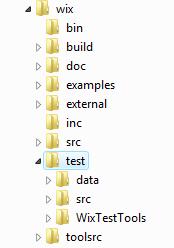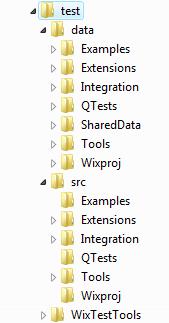Writing WiX Tests
This document describes how to write tests for WiX.
Location of the Tests
The root directory for the tests is %WIX_ROOT%\test. There are three main subdirectories:
- data: contains test data, eg wxs files
- src: contains source code for the tests
- WixTestTools: contains source code for the WixTestTools library

The data and src directories are further organized by feature area:
- Examples: Example tests
- Extensions: Tests for WiX extensions
- Integration: Tests for integration of two or more tools. Eg. Building an MSI from source with Candle and Light.
- QTests: Tests migrated from the previous test infrastructure
- SharedData: Test data that is shared across multiple tests
- Tools: Tests for a particular tool's command line options
- Wixproj: Tests for building .wixproj's with MSBuild

WixTests Solution
The test solution file, WixTests.sln, is located in %WIX_ROOT%\test\WixTests.sln. The WixTests solution currently contains two projects:
- WixTests: Contains all of the tests
- WixTestsTools: A library of wrapper classes and verification methods used by the tests
The solution should be opened from the WiX command window to ensure that the %WIX_ROOT% environment variable is set.
Example Tests
Example: Build and Verify an MSI
The following example shows how to test building an MSI from WiX source.
[TestMethod]
[Description("An example test that verifies an MSI is built correctly")]
[Priority(3)]
public void ExampleTest1()
{
// Use the BuildPackage method to build an MSI from source
string actualMSI = Builder.BuildPackage(@"%WIX_ROOT%\test\data\SharedData\Authoring\BasicProduct.wxs");
// The expected MSI to compare against
string expectedMSI = @"%WIX_ROOT%\test\data\SharedData\Baselines\MSIs\BasicProduct.msi";
// Use the VerifyResults method to compare the actual and expected MSIs
Verifier.VerifyResults(expectedMSI, actualMSI);
}
Example: Check for a Warning and Query an MSI
The following example shows how to build an MSI using the Candle and Light wrapper classes. It also demonstrates how to check for a warning from Light and query the resuling MSI.
[TestMethod]
[Description("An example test that checks for a Light warning and queries the resulting MSI")]
[Priority(3)]
public void ExampleTest2()
{
// Compile a wxs file
Candle candle = new Candle();
candle.SourceFiles.Add(@"%WIX_ROOT%\test\data\Examples\ExampleTest2\product.wxs");
candle.Run();
// Create a Light object that uses some properties of the Candle object
Light light = new Light(candle);
// Define the Light warning that we expect to see
WixMessage LGHT1079 = new WixMessage(1079, WixMessage.MessageTypeEnum.Warning);
light.ExpectedWixMessages.Add(LGHT1079);
// Link
light.Run();
// Query the resulting MSI for verification
string query = "SELECT `Value` FROM `Property` WHERE `Property` = 'Manufacturer'";
Verifier.VerifyQuery(light.OutputFile, query, ".NET Foundation");
}
Example: ICE Validation with Smoke
The following example shows how to verify that Smoke catches a particular ICE violation and how to use the Result object to perform further verification.
[TestMethod]
[Description("An example test that verifies an ICE violation is caught by smoke")]
[Priority(3)]
public void ExampleTest3()
{
string testDirectory = Environment.ExpandEnvironmentVariables(@"%WIX_ROOT%\test\data\Examples\ExampleTest3");
// Build the MSI that will be run against Smoke. Pass the -sval argument to delay validation until Smoke is run
string msi = Builder.BuildPackage(testDirectory, "product.wxs", "product.msi", null, "-sval");
// Create a new Smoke object
Smoke smoke = new Smoke();
smoke.DatabaseFiles.Add(msi);
smoke.CubFiles.Add(@"%WIX_ROOT%\test\data\Examples\ExampleTest3\test.cub");
// Define the expected ICE error
WixMessage LGHT1076 = new WixMessage(1076, "ICE1000: Component 'ExtraICE.0.ProductComponent' installs into directory 'TARGETDIR', which will get installed into the volume with the most free space unless explicitly set.", WixMessage.MessageTypeEnum.Warning);
smoke.ExpectedWixMessages.Add(LGHT1076);
// Run Smoke and keep a reference to the Result object that is returned by the Run() method
Result result = smoke.Run();
// Use the Result object to verify the exit code
// Note: checking for an exit code of 0 is done implicitly in the Run() method but
// this is just for demonstration purposes.
Assert.AreEqual(0, result.ExitCode, "Actual exit code did not match expected exit code");
}